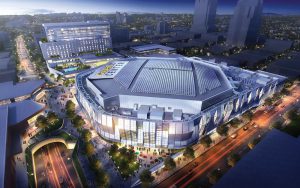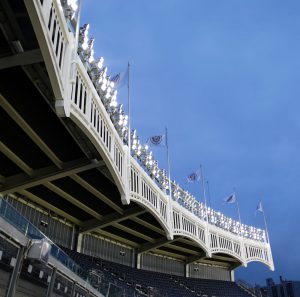The Green Sports Alliance does not ask its members to be perfect, explains Justin Zeulner, Executive Director: “We ask them to show that these goals can be accomplished.”
Nora Goldstein
BioCycle May 2017

The LEED Platinum Golden 1 Center in Sacramento is hosting the 7th Annual Green Sports Alliance Summit. Image courtesy of Golden 1 Center
The 7th Annual Green Sports Alliance Summit is in Sacramento, California, June 27-29 at the Golden 1 Center, home of the Sacramento Kings. The theme for the 2017 Summit — “PLAY GREENER™: Engaging Fans, Athletes & Communities” — focuses on mobilizing Green Sports Alliance members and partners to bring about positive environmental and social impact across their fan base and surrounding communities.
Since its founding in 2011, the Green Sports Alliance (Alliance) has grown to include 188 venues, 180 teams, and 15 leagues. About 75 percent of the venues are home to professional teams (including minor leagues), and 10 percent are collegiate specific. The remaining venues include golf courses, ski resorts and recreation/entertainment venues. Among the Alliance’s league members are the National Basketball Association (men and women), National Hockey League, Major and Minor League Baseball, NASCAR, Major League Soccer, the U.S. Tennis Association and the U.S. Golf Association. Clearly, the Alliance has a significant member and fan base to move the needle on sustainability in North America and globally.
BioCycle recently interviewed Justin Zeulner, the Alliance’s Executive Director, about the strides that have been made over the past six years, many of which are captured in the agenda for the 7th Annual Summit (see box). Zeulner has been involved with the Alliance since its founding, originally as part of the Portland Trail Blazers organization and Vulcan Sports and Entertainment. He became the Alliance’s Executive Director in 2014.
BioCycle: In a recent interview about the National Hockey League’s sustainability achievements, you noted, “everybody should be measuring and reporting on their impacts. Once you do that, you start to set the bar and of course you want to get better every year.”
Where was the bar set when the Alliance started, and how much higher is that bar set today?
Zeulner: The founding members of the Green Sports Alliance set the original proverbial bar of the sports greening movement. Those founders include the Portland Trail Blazers, Seattle Mariners, Seattle Seahawks, Vancouver Cannucks, Seattle Sounders and the Seattle Storm. Our founding members practiced innovation and leadership by implementing varying environmental programs. They each committed to not only measure their environmental impacts, but to get better over time, PLAY GREENER™, as it relates to energy, water, waste, procurement, transportation, food and venue design/operations.
The Trail Blazers were the first to claim LEED Gold in professional sports, the Mariners implemented advanced waste diversion/composting practices, the Seahawks invested in the largest solar energy project in the state of Washington, the Storm developed engagement strategies with their fans, and the Cannucks implemented local/organic food programs. And the list goes on and on.

Fans embrace having local and organic food options (left), which help to support regional economies. Blaze, the Portland Trail Blazers mascot (right), unveils the electric vehicle charging stations at the Moda Center where the NBA team plays. Photos courtesy of the Green Sports Alliance
These innovations rapidly became the norm and now we see further advancements. These include the strive for LEED Platinum, environmentally intelligent food programs and on-site gardens, advancement of renewable energy projects, enhanced community and fan engagement, zero waste, food donation and composting, massive energy efficiencies, including LED stadium and arena lights, water conservation, EV charging stations, and venues being designed that support community goals. In less than a decade, we have witnessed the establishment of a social movement and implementation of progressive environmental programs.
BioCycle: Of the Alliance’s four member categories — venues, leagues, teams and corporate — do interest and a commitment to greening tend to start primarily with the venues, especially if they benefit from cost-savings, or achieving LEED credits?
Zeulner: Interest in joining the sports greening movement is inspired by varying people within our member organizations. Sometimes it comes from innovators within operations, sometimes from Presidents/CEOs and League Commissioners, or it can come from a part-time usher that has a drive for sustainability or from an academic leader on a college campus. Honestly, these journeys seem to have endless beginnings. All find operational savings from implementing environmental stewardship programs, from energy to water to waste, etc., but that’s just the beginning of these stories. Authentically embracing these practices enables a deeper connection to our communities and fans. It strengthens the value of our brands, makes us more resilient, enables economic growth and enhances the entertainment experience.
BioCycle: Can you provide some examples?

The LED lights installed at Yankee Stadium are an example of an innovation that has rapidly become the norm at sports venues.
Zeulner: Installation of LED lights at arenas and stadiums drastically reduces the amount of energy needed to hold a sporting event. That is true. But these lights also have human health benefits — players are citing the benefits of playing in lights that mimic sunlight. They also enhance the television broadcasting, and perhaps most important of all, the LEDs provide a platform to educate and raise awareness. These types of lights can be installed in our schools, community centers, in our businesses and homes. This enables us to leverage the cultural and market influence of sports to create healthier communities.
Food and beverage programs are another example, and include implementing strategies around sourcing, menu design, equipment and prep, food donation and composting. The impacts and benefits of implementing ecologically intelligent food programs are vast. Fans rave about the value of having local and organic food options at our venues, which supports regional economies.
BioCycle: What are some of the most exciting developments you’ve seen with regard to Zero Waste initiatives at venues?
Zeulner: The advancement of composting and organic waste operations has enabled the sports industry to further its goals in striving towards zero landfill objectives. The private sector and our corporate partners have worked intimately with our sports members to implement strategies. Initiating these programs, the bioplastics industry has opened the door to further discussions regarding all purchasing involving plastics. Any and all plastic is a hot topic within the industry, not only food and beverage containers, but everything from merchandising to venue seats. All of this will be discussed at our June Green Sports Alliance Summit in Sacramento at the LEED Platinum Golden 1 Center.
Additionally, food donation programs have seen rapid adoption. The environmental and social impacts of food waste have been well documented and the sports industry is implementing strategies that support their local communities, while reducing ecological impacts. The concessionaires of the sports and entertainment industry, the leagues, our members and nonprofit partners like Rock ‘N’ Wrap it Up! are supporting the adoption and implementation of these programs.
BioCycle: The Alliance’s partners include a range of professional and trade associations that reflect opportunities for collaboration. What makes these alliances so important?
Zeulner: The ability for us to achieve our mission, to create healthier communities where we live and play, requires partnerships and involvement of all stakeholders. Since our public launch in March 2011, we have worked closely with other organizations that share The Alliance’s values and goals, such as the Natural Resources Defense Council, the International Association of Venue Managers, the Association for the Advancement of Sustainability on Higher Education, Protect Our Winters, U.S. Department of Energy, U.S. EPA, National Institute of Building Sciences, Sustainable Surf, Sailors for the Sea and many more.
Recently, we announced partnerships with the British Association for Sustainable Sport and further collaborations with the ski industry — welcoming a handful of ski resorts as members and establishing a relationship with the National Ski Area Association. We have also added relationships with the golf industry. U.S. Golf Association has become a member, establishing a relationship with PGA of America and another handful of golf courses and resorts joining the Alliance.
Why is the expansion of our movement into other sports sectors, the move to think globally so important? It is critical to scale the impacts at a rapid rate. Partnerships and collaborations enable us to collectively seek opportunities to harmonize and learn from each other. Climate change is accelerating our need to act swiftly. The stakes are high, the time to act is now.
BioCycle: Influencing teams, venues, fans and partners to change behaviors and practices can be met with resistance. Where is the Alliance experiencing the most resistance to behavior and value change? Where is it experiencing the least resistance?
Zeulner: From my perspective, the largest challenges facing adoption of increased environmental sustainability practices — whether that be from the sports industry, the private sector or the general public—is not knowing what to do, where to begin. That’s a hard thing for some people to acknowledge, especially in an age of technology that enables us to learn and make endless choices. That said, we are asked to take so many actions, sometimes with limited support, that it results in very little action being taken. That’s one of the greatest storylines here with our movement. We convene. We provide resources. We inspire change. We do not ask our members to be perfect, merely to PLAY GREENER™ over time — to share their stories with others, showing that these goals can be accomplished.
BioCycle: What’s on tap for Green Sports Day™ 2017? Any teasers we can mention?
Zeulner: We worked in conjunction with the White House, our league, association and conference stakeholders, Alliance members and sports greening partners to declare and establish the inaugural Green Sports Day ™ on October 6, 2016. This year on October 6, 2017, we will celebrate the success of our movement, take time to celebrate our collective progress, announce future commitments, and inspire everyone to take the actions necessary to create healthy communities where we live and play.










